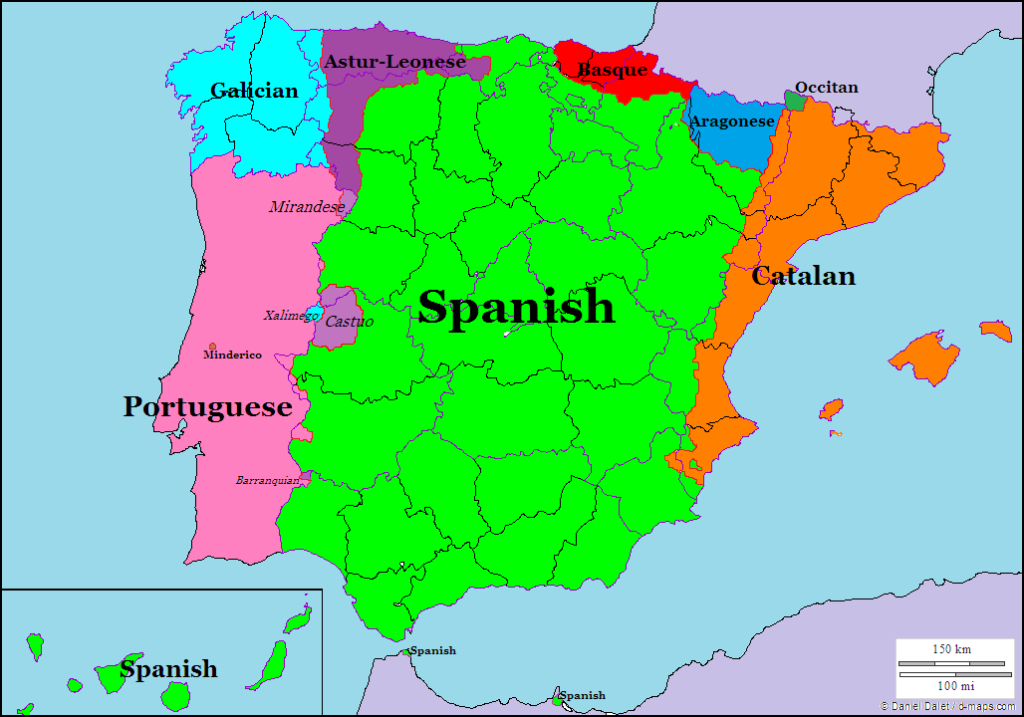The Spanish language
The languages spoken in Spain cause great confusion abroad, as they have different dialects. There is a total of five official languages in Spain (Spanish, Catalan, Basque, Galician, and Aranees) and two non-official (Asturian and Aragonese). Spanish is the only official national language of Spain. The remaining four are official languages of some areas.

Languages in Spain:
The four official regional languages of Spain:
- Catalan (Spanish: Catalan, Catalan: Català): spoken by slightly more than 18% of the total population, or 7.5 million people in Catalonia, the Balearic Islands and the Comunidad Valenciana. Strictly linguistically speaking, Catalan spoken in Valencia is not but Valencian Catalan (SP: Valenciano CA: Valencià). Today, however, there are few differences between these two languages, that is why Valencian is considered as Catalan language.
- Basque (ES: Vasco, BA: Euskara): spoken by slightly more than 1 million people in the Basque Country and Navarre, 2.3% of the total Spanish population. The Basque language has no similarity to any other language.
- Galician (ES: Gallego, GA: Galego): spoken by slightly more than 2.5 million people, 5.7% of the total Spanish population in Galicia, and parts of León and Asturias. The language seems more Portuguese than Spanish.
- Aranees: is spoken by only 4,000 people in the Val d’Aran in Catalonia. Linguistically speaking, it is regarded as a dialect of Occitan, the remainder is mainly spoken in France.

Spanish, Catalan, Galician, and Aranees are all Romance languages, originally dialects of Latin. Basque is a special case, as it is totally different from any language in the world.
The two non-official regional Spanish languages are:
- Asturian (ES: Asturiano AS: Asturianu) is spoken by about 100,000 people, and in Asturias is legally protected. It is not a dialect of Spanish, but a separate language and is spoken in different regions: Asturias, León, Zamora, Salamanca (called “llionés”), Extremadura (called “extremeñu”) and Cantabria ( called “Montanes”).
- Aragonese (ES: Aragonés, AR: Aragonés): is spoken by only 10,000 people in the province of Huesca, Aragon. Approximately 40,000 people speak the language or have learned it (neo-fabláns), mostly in Zaragoza and Huesca. In the remainder of Aragon, south of Navarre and some regions of Valencia and Castilla-La Mancha, it is often mixed with Spanish. The Aragonese comes from Latin.
The four official regional languages of Spain play a relatively important role, both regionally and nationally. 24% of the Spanish population speaks one of the four official regional languages, which amounts to nearly 11 million residents.
Spain has also many dialects and slangs. The best example is the variety of Spanish spoken in Andalucia by about 7 million people, with large variations in vocabulary and pronunciation. It is called “Andaluz” (Andalusian) and it is difficult to understand for many other Spaniards. Valencian, a variant of Catalan is spoken in the region of the same name. However, Valencian is sometimes considered a separate language.






